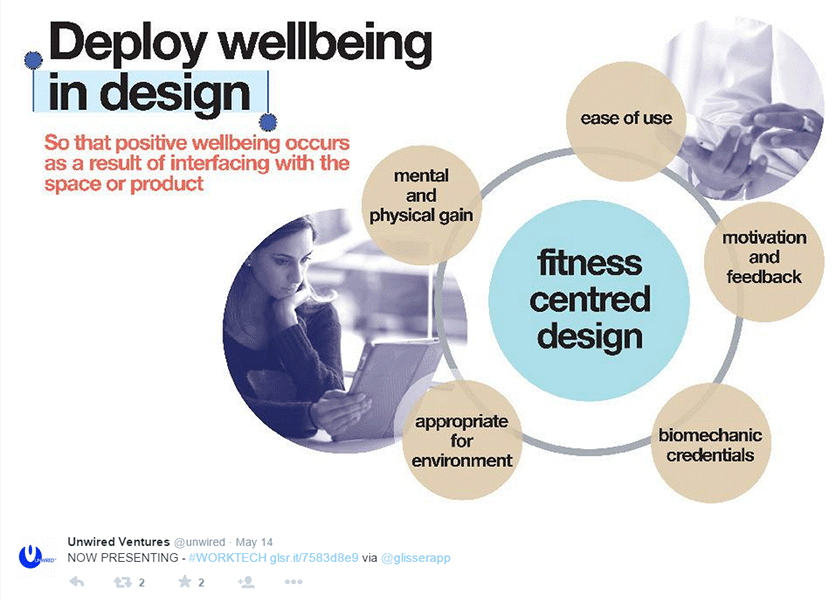Part II of II: IA Workplace Strategist Shih Hua Liong joined the conversation around the future of workplace at the recent New York edition of WorkTech.

People & Workplace Wellbeing
I found it reassuring that wellbeing in the workplace was at the forefront of many conversations at Worktech this year. Demonstrating that was Jim Taylour, head of workplace wellbeing at Orangebox and co-founder and chair of a special interest group on children’s ergonomics with the Institute of Ergonomics and Human Factors (IEHF).
Two key words in his talk that struck a chord: fitness-centered design and wireless wellbeing. According to Orangebox’s Mobile Generation research regarding fitness-centered design, also commonly referred to as active design, we need to intentionally plan for opportunities and experiences that provide a positive physical and psychological outcome in in our static work environment.

Now more than ever, we are dependent on our mobile devices 24/7. What is the impact not just in the workplace, (being “on-call” or perpetually reachable via email), but also to our children’s wellbeing at home and at school? Eye-opening statistics were shared around tablet use in among young people—from vision health to postures and ergonomics—how can we be more cognizant of wireless wellbeing for the mobile generation. According to research cited, the human race is also getting heavier and taller, which means the anthropometric data we are currently using does not represent the current working population, and the speed of change suggests that future data will need to be updated more regularly.
In addition, we heard from Martha Clarkson, global workplace strategist and manager of the experience design program in Microsoft’s real estate group, who talked about how the company has introduced “no tech” zones in their workplace. At IA, we are also seeing more and more of these ideas being introduced in workplace planning. As a global shift, consider the increased media exposure we are seeing on happiness at work, such as the Happiness at Work Survey, the Happy Planet Index, and the International Well Building Institute whose mission is to improve human health and wellbeing through the built environment. We also see this emphasis and focus on workplace well-being in the recent 2015 Executive Report on Workplace Wellbeing from the IIDA Annual Industry Roundtable, where 30 members of the real estate and design community provided new perspectives on the importance of human-centered design.

The Future of FinTech
A major topic of discussion centered on ways the tech industry—talent, space, culture—is influencing the financial industry. The financial workplace is evolving, not just in the US but also in the UK, and I think this is one of the biggest disruptors to the corporate workplace as we know it today. Phil Kirschner, director and the Americas head of workplace strategy at Credit Suisse, shared a great example of this evolution with Credit Suisse Smart Working. The program focuses on how best to use policies, space, and advances in mobile technologies to address changing workplace preferences and reduce occupancy expenses through better utilization of analytics to inform space strategies and performance.
How far have we progressed in “workplace?” Not as much as we’d like to think, according to Robert Lucchetti. He posits that the ideas published in a Harvard Business Review article from 1985 remain at the forefront of workplace planning practices nearly 30 years later. Beyond the basics of square footage, workstations, and office allocation, it is reassuring that we are elevating the conversation to all the ‘softer’ qualities of the workplace. Components that were not part of the prior discussion around work and the workplace are now at the forefront of our work-life minds. From New York to London to New Zealand, it’s a global conversation in which I’m thrilled to be included.
The question is: “Do we, as the owners, facilitators, builders, designers, planners of work and place, dare to go further?”
The answer should be: “Absolutely!”
